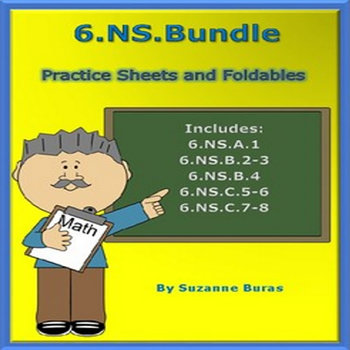Number System Bundle: CCSS 6.NS.1-8
- Zip
- Easel Activity
Products in this Bundle (10)
showing 1-5 of 10 products
Also included in
- This product includes EVERYTHING from my 6th Grade CCSS Math products for all standards.Almost 750 pages!!This includes:6.NS - Number System6.RP - Ratio and Proportional Relationships6.G - Geometry6.EE - Expressions and Equations6.SP - Statistics and ProbabilityEach of the above contains:1. FoldPrice $230.40Original Price $256.00Save $25.60
Description
This Bundle addresses concepts related to the sixth grade CCSS
Number System Standards:
6.NS.A.1
6.NS.B.2-3
6.NS.C.4
6.NS.C.5-6
6.NS.D.7-8
IMPORTANT NOTE: The packets below can be purchased separately or as a bundle. Make sure you don't double dip and pay twice for the same thing!!!
NOTE: This product is also a part of my Complete Packaged Unit (All practice sheets, foldables, PowerPoint, Posters, Assessments, and Task Cards)!
Visit Suzanne's Classroom Store!
The resources are designed to enrich or supplement your current curriculum.
Click the links to view each packet in the bundle. These can also be purchased separately:
Dividing Fractions and Mixed Numbers: 6.NS.A.1
Addition, Subtraction, Multiplication, Division of Multi-Digit Numbers and Decimals: 6.NS.B.2-3
GCF, LCM, Distributive Property: 6.NS.B.4
Number Lines and Coordinate Planes with Positive and Negative Numbers - 6.NS.C.5 & 6.a-c
Number System: Ordering, Inequality, and Absolute Value - 6.NS.C 7-8
6.NS.1-8 "Helps" PowerPoint Presentation
Number System Helps and Hints Posters: 6.NS.1-8
Number System Assessments: 6.NS.1-8
Number System Task Cards BINGO: 6.NS.1-8
6th Grade Interactive Notebook Aides and Foldables For Number System: 6.NS.1-8
For the COMPLETE package of all these products that includes the practice sheets, foldables, PowerPoint, Posters, Assessments, and Task Cards, click here!



